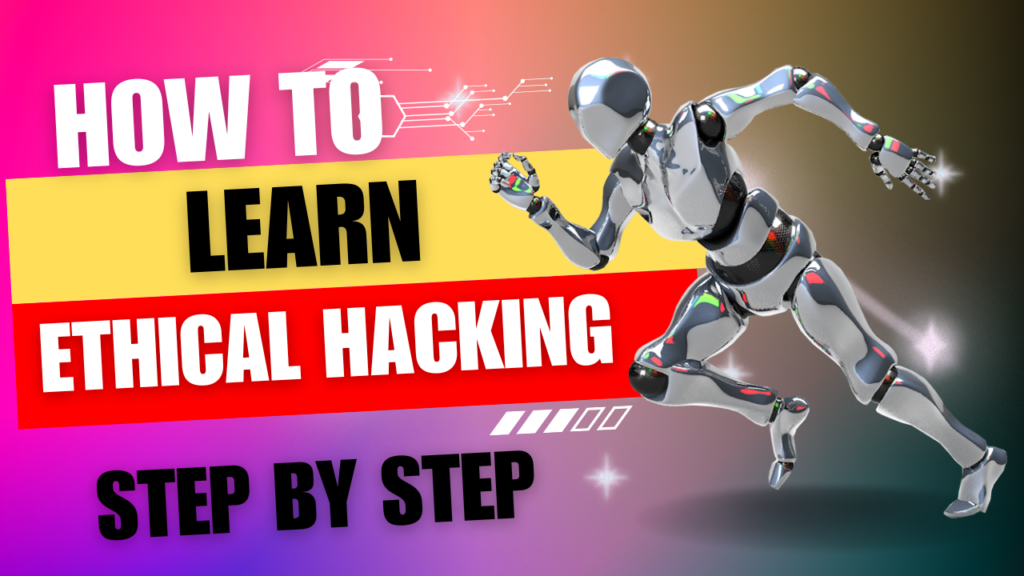
Introduction:
How to Learn Ethical Hacking: Learning ethical hacking is not merely a technical pursuit; it is a quest to fortify the digital world against malevolent forces. As we embark on this journey, we’ll traverse the foundational landscapes, scale the peaks of knowledge, and navigate the valleys of challenges, all with the ultimate aim of becoming the guardians of cybersecurity. ethical hacking stands as a noble and indispensable pursuit. If you’ve ever wondered how to learn ethical hacking step by step, you’re in the right place. This blog will serve as your roadmap, guiding you through the essential steps to embark on this exciting and impactful journey of becoming an ethical hacker. the guardians of our virtual realms stand at the forefront, defending against unseen threats and securing the fabric of our online existence. Ethical hacking, a noble and dynamic discipline, empowers individuals to harness their technical prowess for the greater good. If you’ve ever felt the call to explore the world of ethical hacking, this guide is your compass, leading you through the intricate terrain of cybersecurity.
Learn Ethical Hacking: Understand the Basics
Embarking on the journey to learn ethical hacking necessitates a solid grasp of the fundamentals. This initial phase serves as the bedrock, providing you with the essential knowledge that will underpin your entire exploration of cybersecurity.
1. Computer Networks: The Foundation of Connectivity
Begin by unraveling the intricate world of computer networks. Grasp the basics of how data travels from one point to another in a network, the role of protocols such as TCP/IP, and the significance of devices like routers and switches. Understand the nuances of IP addressing, subnetting, and the mechanisms that facilitate seamless communication across the digital landscape.
2. Operating Systems: Navigating the Digital Terrain
Operating systems are the command centers of computing devices. Familiarize yourself with the ins and outs of popular operating systems, with a particular emphasis on Linux. Explore the command-line interface (CLI), file systems, and basic system administration tasks. A robust understanding of operating systems is crucial as ethical hacking often involves interacting with diverse environments.
3. Programming Languages: The Language of Ethical Hackers
Programming is the language through which ethical hackers communicate with computers. While several languages are relevant, Python stands out for its simplicity and versatility. Learn the basics of Python programming, including variables, loops, and functions. Python will become an invaluable tool for scripting, automation, and developing custom hacking tools.
4. Online Platforms and Communities: Learning in a Connected World
Embrace the wealth of online resources and communities dedicated to ethical hacking. Platforms like Hack The Box, TryHackMe, and GitHub offer hands-on labs, challenges, and collaborative spaces where you can apply your knowledge in a practical setting. Engage with forums, participate in discussions, and absorb insights from the vibrant ethical hacking community.
5. Virtual Labs: Turning Theory into Practice
Theory alone is insufficient; practical application is paramount in ethical hacking. Set up virtual labs using tools like VirtualBox or VMware to create simulated environments. Practice configuring networks, experimenting with different operating systems, and executing basic scripting tasks. Virtual labs provide a risk-free space to apply your newfound knowledge.
6. Certifications: Formalizing Your Knowledge
Consider pursuing foundational certifications that validate your understanding of the basics. Certifications such as CompTIA Network+, CompTIA Linux+, or Cisco’s CCNA provide recognized credentials and structured learning paths. While not mandatory, certifications can boost your confidence and credibility in the field.
Embrace Networking Fundamentals
Understanding the intricacies of computer networks is fundamental to becoming an ethical hacker. Networking forms the backbone of digital communication, and a solid grasp of these fundamentals is essential for navigating the cybersecurity landscape.
1. Delving into Network Architectures: OSI Model and TCP/IP Suite
Start by acquainting yourself with the Open Systems Interconnection (OSI) model and the Transmission Control Protocol/Internet Protocol (TCP/IP) suite. These conceptual frameworks lay the foundation for understanding how data is transmitted across networks. Break down the layers of the OSI model and explore the roles of protocols like TCP, IP, UDP, and ICMP in the TCP/IP suite.
2. IP Addressing and Subnetting: Navigating the Digital Address Space
Dive into the world of IP addressing and subnetting, essential components for effective network communication. Learn the different classes of IP addresses, grasp the concept of subnets, and understand how subnetting helps in efficiently managing IP address spaces. This knowledge is crucial for ethical hackers when dealing with network configurations and identifying potential vulnerabilities.
3. Networking Devices: Routers, Switches, and Beyond
Explore the role of networking devices in shaping the flow of data within a network. Understand the functions of routers, switches, hubs, and firewalls. Learn how these devices operate at different layers of the OSI model and contribute to the overall efficiency and security of a network.
4. Protocols and Ports: Gatekeepers of Network Communication
Dive into the world of network protocols and ports. Understand how protocols facilitate communication between devices and how ports act as gatekeepers for specific services. Learn about common protocols like HTTP, HTTPS, FTP, and SSH, and their associated port numbers. This knowledge is crucial for ethical hackers when analyzing network traffic and identifying potential vulnerabilities.
5. Wireshark: Unveiling the Network Traffic
Hands-on experience is paramount in understanding networking fundamentals. Explore Wireshark, a powerful network protocol analyzer. Learn how to capture and analyze network traffic, dissecting packets to gain insights into the communication between devices. Wireshark provides a real-world perspective on how data flows through a network.
6. Secure Network Communication: VPNs and Encryption
Dive into the realm of secure network communication. Understand how Virtual Private Networks (VPNs) ensure encrypted and private data transfer over public networks. Explore encryption protocols such as SSL/TLS and IPSec, which play a crucial role in securing data during transmission. Ethical hackers must comprehend these technologies to identify and address potential vulnerabilities in secure communication channels.
Mastering Operating Systems and Command Line Interfaces
Operating systems serve as the command centers of computing, and for ethical hackers, mastering these systems is akin to navigating the heart of digital landscapes. This phase of your journey involves a deep dive into operating systems, with a specific emphasis on Linux, and becoming fluent in the command-line interface (CLI).
1. Understanding Operating System Fundamentals
Begin by developing a solid understanding of operating system fundamentals. Explore the core concepts of process management, memory management, file systems, and security mechanisms. Recognize the differences between popular operating systems like Windows, macOS, and Linux. While each has its nuances, focus on Linux due to its prevalence in cybersecurity and ethical hacking environments.
2. Embracing the Linux Environment
Linux is the go-to operating system for ethical hackers, thanks to its open-source nature, robust security features, and flexibility. Familiarize yourself with different Linux distributions (distros) such as Ubuntu, Kali Linux, and CentOS. Understand the Linux file system hierarchy, user permissions, and package management.
3. Command-Line Mastery
The command line is the hacker’s canvas, where keystrokes translate into powerful actions. Grasp the essentials of the command-line interface (CLI) in Linux. Learn common commands for file manipulation, directory navigation, and user management. Understanding the CLI is essential for efficient and precise interaction with operating systems.
4. Shell Scripting: Automating Tasks
Delve into shell scripting, a skill that separates the novice from the adept. Learn scripting languages like Bash to automate repetitive tasks, create custom tools, and streamline processes. Scripting is invaluable for ethical hackers, allowing them to efficiently execute commands and analyze data.
5. Advanced Linux Concepts
Elevate your Linux proficiency by exploring advanced concepts. Understand networking configurations, system logs, and kernel modules. Familiarize yourself with package management systems, and delve into the intricacies of system administration. Advanced Linux knowledge enables ethical hackers to navigate complex environments and troubleshoot issues effectively.
6. Virtualization: Creating Sandbox Environments
Explore virtualization tools like VirtualBox or VMware to create isolated, sandboxed environments. Virtual machines (VMs) allow you to experiment with different operating systems, configurations, and security settings without affecting your primary system. This hands-on experience is invaluable for mastering operating systems in diverse scenarios.
7. Real-world Practice: Capture The Flag (CTF) Challenges
Apply your operating system and command-line skills in real-world scenarios by participating in Capture The Flag (CTF) challenges. CTFs provide practical exercises where you can showcase your proficiency in exploiting vulnerabilities, analyzing logs, and navigating through diverse environments.

Learn Programming and Scripting
Programming is the backbone of ethical hacking, providing the ability to automate tasks, create custom tools, and understand the intricacies of vulnerabilities. In this phase of your journey, you will delve into programming languages, with a specific focus on mastering Python, a versatile language widely used in the field of cybersecurity.
1. Why Python?
Python is a language of choice for ethical hackers due to its simplicity, readability, and a wealth of libraries and frameworks. It is employed for scripting, automation, tool development, and even building full-fledged applications. As you venture into programming, Python will become an invaluable ally in your ethical hacking toolkit.
2. Basics of Python Programming
Begin by familiarizing yourself with the basics of Python programming. Understand variables, data types, control structures (if statements, loops), and functions. Online interactive platforms like Codecademy or Python.org’s official tutorial are excellent resources for hands-on learning.
3. Data Structures and Algorithms
Develop a strong foundation in data structures and algorithms. These concepts are essential for solving complex problems efficiently. Learn about lists, dictionaries, sets, and more. Practice solving algorithmic challenges on platforms like LeetCode or HackerRank to enhance your problem-solving skills.
4. Python Libraries for Ethical Hacking
Explore Python libraries that are specifically tailored for ethical hacking and cybersecurity. Familiarize yourself with libraries such as Requests for HTTP interactions, BeautifulSoup for web scraping, and Scapy for packet manipulation. These libraries empower ethical hackers to perform a wide range of tasks efficiently.
5. Ethical Hacking with Python
Transition into ethical hacking scenarios by combining your Python knowledge with practical applications. Learn to write scripts for tasks like network scanning, vulnerability assessment, and exploitation. Platforms like Hack The Box and OverTheWire offer environments where you can apply your Python skills to real-world challenges.
6. Web Development for Security Testing
Understanding web technologies is crucial for ethical hackers. Learn the basics of web development, including HTML, CSS, and JavaScript. Familiarize yourself with web application frameworks like Flask or Django. This knowledge will aid you in comprehending and exploiting web-based vulnerabilities.
7. Continuous Practice and Challenges
Programming is a skill that improves with continuous practice. Engage in coding challenges, contribute to open-source projects, and participate in programming communities. Platforms like GitHub provide opportunities to collaborate with other developers and showcase your projects.
8. Online Courses and Certifications
Consider enrolling in online courses or certifications that focus on Python programming for ethical hacking. Platforms like Cybrary and Offensive Security offer specialized courses that guide you through the practical application of Python in a cybersecurity context.
Resources for Specialized Courses:
Cybrary’s “Python for Security Professionals” course.
Offensive Security’s “PWK: Penetration Testing with Kali Linux” certification.
Explore Web Application Security
In the ever-evolving landscape of cybersecurity, web applications stand as prime targets for malicious actors. Exploring web application security is a crucial phase in your journey as an ethical hacker, as it involves understanding and mitigating vulnerabilities that can be exploited to compromise sensitive data, disrupt services, or launch attacks.
1. Understanding the Web Application Architecture
Before diving into security considerations, it’s essential to understand the architecture of web applications. Explore the components such as client-side scripts (JavaScript), server-side scripts (PHP, Python, Ruby), databases (MySQL, PostgreSQL), and communication protocols (HTTP/HTTPS). This knowledge forms the basis for identifying potential security loopholes.
Resources for Beginners:
Online courses on web development and architecture.
Books like “Web Development and Design Foundations with HTML5” by Terry Felke-Morris.
2. Common Web Application Vulnerabilities
Familiarize yourself with common web application vulnerabilities that ethical hackers frequently encounter. These include:
SQL Injection: Exploiting poorly sanitized input to manipulate a database.
Cross-Site Scripting (XSS): Injecting malicious scripts into web pages viewed by other users.
Cross-Site Request Forgery (CSRF): Forcing users to perform actions without their consent.
Security Misconfigurations: Improperly configured security settings that expose sensitive information.
Understand the impact of these vulnerabilities and how they can be exploited by attackers to compromise web applications.
Resources for Beginners:
Online tutorials and guides on platforms like OWASP.
Books like “The Web Application Hacker’s Handbook” by Dafydd Stuttard and Marcus Pinto.
3. Web Application Scanners and Tools
Explore web application security scanners and testing tools. Tools like Burp Suite, OWASP ZAP, and Acunetix aid in identifying vulnerabilities by simulating attacks and analyzing the application’s responses. Learn how to configure and use these tools effectively to perform automated security assessments.
Resources for Beginners:
Online tutorials and documentation are provided by tool vendors.
Practical exercises and challenges on platforms like Hack The Box or PortSwigger Web Security Academy.
4. Secure Coding Practices
Understanding how secure code is written is paramount for ethical hackers. Explore secure coding practices to prevent common vulnerabilities during the development phase. Learn about input validation, output encoding, and other techniques to fortify web applications against potential attacks.
Resources for Beginners:
Online courses on secure coding practices.
Books like “Secure Coding in C and C++” by Robert C. Seacord.
5. Web Application Firewalls (WAF)
Explore the role of Web Application Firewalls in enhancing security. Understand how WAFs filter and monitor HTTP traffic between a web application and the Internet. Learn how to configure and deploy WAFs to protect web applications from various attacks, providing an additional layer of defense.
Resources for Beginners:
Online courses on WAF implementation and configuration.
Documentation provided by WAF vendors.
6. Hands-on Web Application Security Testing
Put your knowledge into practice by engaging in hands-on web application security testing. Platforms like OWASP WebGoat or Damn Vulnerable Web Application (DVWA) provide controlled environments for ethical hackers to practice exploiting vulnerabilities in a safe and legal manner.
Resources for Beginners:
Online platforms offer realistic web application security challenges.
Books like “Metasploit: The Penetration Tester’s Guide” by David Kennedy, Jim O’Gorman, Devon Kearns, and Mati Aharoni.
7. Responsible Disclosure and Reporting
Understand the ethical aspects of web application security testing. If you discover vulnerabilities in a web application, follow responsible disclosure practices. Learn how to report vulnerabilities to the respective organizations and work collaboratively towards improving the security posture.
Resources for Beginners:
Guidelines and best practices for responsible disclosure from organizations like Bugcrowd or HackerOne.
Online forums and communities that discuss responsible disclosure processes.
Understanding System Security
System security is a critical facet of cybersecurity, encompassing the protection of computer systems, networks, and data from unauthorized access, attacks, and damage. In this phase of your ethical hacking journey, delve into the intricacies of system security to fortify digital environments against potential threats.
1. Core Concepts of System Security
Begin by understanding the foundational concepts of system security. Explore the principles of confidentiality, integrity, and availability (CIA triad), which form the cornerstone of secure systems. Comprehend how these principles guide security measures to ensure data privacy, prevent unauthorized alterations, and maintain the accessibility of resources.
Resources for Beginners:
Online courses covering the fundamentals of cybersecurity and system security.
Books like “CISSP All-in-One Exam Guide” by Shon Harris.
2. User Authentication and Authorization
User authentication and authorization are integral components of system security. Learn how systems validate the identities of users and grant appropriate access permissions. Explore techniques such as multi-factor authentication (MFA) and role-based access control (RBAC) to enhance the security of user accounts.
Resources for Beginners:
Online tutorials on authentication and authorization mechanisms.
Books like “Hacking: The Art of Exploitation” by Jon Erickson.
3. Privilege Escalation Techniques
Delve into the realm of privilege escalation, a common target for attackers seeking to gain unauthorized access. Understand how privilege levels are assigned to users and the potential vulnerabilities that can be exploited to elevate these privileges. Learn about techniques used in privilege escalation attacks and how to safeguard against them.
Resources for Beginners:
Online platforms offering labs on privilege escalation challenges.
Books like “Metasploit: The Penetration Tester’s Guide” by David Kennedy, Jim O’Gorman, Devon Kearns, and Mati Aharoni.
4. Malware and Antivirus Solutions
Explore the landscape of malware, and malicious software designed to harm or exploit systems. Understand different types of malware, including viruses, worms, trojans, and ransomware. Learn about antivirus solutions and their role in detecting and mitigating malware threats.
Resources for Beginners:
Online courses on malware analysis and antivirus technologies.
Books like “Practical Malware Analysis” by Michael Sikorski and Andrew Honig.
5. Intrusion Detection and Prevention Systems (IDPS)
Intrusion Detection and Prevention Systems are crucial components for identifying and thwarting security threats. Understand how these systems analyze network and system activities to detect suspicious behavior and prevent unauthorized access. Explore different types of IDPS and their roles in enhancing overall system security.
Resources for Beginners:
Online courses on intrusion detection and prevention.
Books like “Intrusion Detection Systems” by Richard Bejtlich.
6. Security Patching and Updates
System vulnerabilities often arise from outdated software and unpatched systems. Learn the importance of regular security patching and system updates to address known vulnerabilities. Understand the challenges associated with patch management and explore best practices for keeping systems secure.
Resources for Beginners:
Online tutorials on system patching and updates.
Documentation from operating system vendors on best practices for system maintenance.
7. Incident Response and Forensics
Prepare for security incidents by understanding the fundamentals of incident response and digital forensics. Learn how to effectively respond to security breaches, analyze incidents, and gather evidence for investigations. Explore tools and techniques used in digital forensics to trace and understand security incidents.
Resources for Beginners:
Online courses on incident response and digital forensics.
Books like “Incident Response & Computer Forensics” by Jason Luttgens, Matthew Pepe, and Kevin Mandia.
8. Security Configuration Management
Explore the world of security configuration management, focusing on configuring systems securely to reduce the attack surface. Understand the significance of hardening systems, restricting unnecessary services, and implementing secure configurations to mitigate potential security risks.
Resources for Beginners:
Online tutorials on security configuration management best practices.
Books like “Security Engineering: A Guide to Building Dependable Distributed Systems” by Ross J. Anderson.
Familiarize Yourself with Ethical Hacking Tools
Ethical hacking is empowered by a diverse arsenal of tools designed to assess and fortify the security of computer systems, networks, and applications. In this phase of your journey, immerse yourself in the world of ethical hacking tools, each serving a unique purpose in identifying vulnerabilities, conducting penetration tests, and enhancing overall cybersecurity.
1. Introduction to Ethical Hacking Tools
Understand the landscape of ethical hacking tools, which can be broadly categorized into:
Scanning Tools: Used for reconnaissance and mapping of network and system vulnerabilities.
Exploitation Tools: Employed to exploit identified vulnerabilities for testing and mitigation purposes.
Post-Exploitation Tools: Facilitate activities after successful system compromise, including privilege escalation and lateral movement.
Forensic Tools: Aid in the analysis of security incidents and digital forensics investigations.
2. Network Scanning Tools
Explore tools designed for network scanning, which involves identifying active hosts, open ports, and potential vulnerabilities within a network. Tools like Nmap and Nessus provide comprehensive scanning capabilities, helping ethical hackers assess the security posture of systems.
Resources for Beginners:
Online tutorials on using Nmap for network scanning.
Books like “Nmap Network Scanning” by Gordon Fyodor Lyon.
3. Vulnerability Assessment Tools
Engage with vulnerability assessment tools that help identify and prioritize potential security vulnerabilities within systems. Tools like OpenVAS and Nexpose automate the process of scanning and reporting vulnerabilities, enabling ethical hackers to proactively address weaknesses.
Resources for Beginners:
Online courses on vulnerability assessment using OpenVAS.
Documentation provided by vulnerability assessment tool vendors.
4. Exploitation Frameworks
Delve into exploitation frameworks that facilitate the testing of identified vulnerabilities. Metasploit, a renowned exploitation framework, provides a vast array of modules for various exploits, making it an essential tool for ethical hackers conducting penetration tests.
Resources for Beginners:
Online tutorials on using Metasploit for penetration testing.
Books like “Metasploit: The Penetration Tester’s Guide” by David Kennedy, Jim O’Gorman, Devon Kearns, and Mati Aharoni.
5. Wireless Hacking Tools
Explore tools designed for ethical hacking in wireless networks. Tools like Aircrack-ng and Wireshark assist in assessing the security of Wi-Fi networks, identifying vulnerabilities, and analyzing wireless traffic for potential threats.
Resources for Beginners:
Online guides on using Aircrack-ng for wireless penetration testing.
Books like “Wireshark 101: Essential Skills for Network Analysis” by Laura Chappell.
6. Web Application Security Tools
Familiarize yourself with tools specifically tailored for assessing and securing web applications. Burp Suite, OWASP ZAP, and Nikto are widely used for web application testing, identifying common vulnerabilities like SQL injection and Cross-Site Scripting (XSS).
Resources for Beginners:
Online tutorials on using Burp Suite for web application security testing.
Books like “The Web Application Hacker’s Handbook” by Dafydd Stuttard and Marcus Pinto.
7. Post-Exploitation Tools
Explore tools used after a successful exploitation, focusing on tasks like privilege escalation and lateral movement. Tools like PowerSploit and Mimikatz assist ethical hackers in understanding and exploiting Windows systems’ post-exploitation vulnerabilities.
Resources for Beginners:
Online guides on post-exploitation techniques using PowerSploit.
Books like “Mimikatz Guide” by Adrien de Beaupré.
8. Forensic Tools
Dive into forensic tools that aid in investigating security incidents and analyzing digital evidence. Tools like The Sleuth Kit and Autopsy provide functionalities for file system analysis, data recovery, and timeline reconstruction.
Resources for Beginners:
Online courses on digital forensics using The Sleuth Kit.
Books like “Digital Forensics with Open Source Tools” by Cory Altheide and Harlan Carvey.
9. Continuous Learning and Updates
Ethical hacking tools evolve rapidly to keep pace with emerging threats and technologies. Stay informed about the latest tools, updates, and industry trends. Engage with online communities, and forums, and attend conferences to exchange knowledge and insights with fellow ethical hackers.
Resources for Continuous Learning:
Online communities like GitHub and Stack Overflow for tool discussions.
Conferences such as DEF CON and Black Hat for staying updated on the latest tools and techniques.
Pursue Ethical Hacking Certifications
Earning certifications in ethical hacking is a crucial step in formalizing your skills, gaining industry recognition, and showcasing your expertise to potential employers. These certifications validate your proficiency in various aspects of ethical hacking and cybersecurity. Here is a guide to pursuing ethical hacking certifications.
Preparation:
Enroll in an official CEH training program or use self-study resources.
Practice hands-on labs to reinforce theoretical knowledge.
Take practice exams to familiarize yourself with the exam format.
Resources:
Official CEH study materials and training courses.
Books like “CEH Certified Ethical Hacker All-in-One Exam Guide” by Matt Walker.
2. OSCP (Offensive Security Certified Professional)
Overview: Offered by Offensive Security, the OSCP certification is highly regarded for its hands-on approach. It requires candidates to pass a challenging 24-hour practical exam where they must exploit a series of machines within a dedicated environment.
Preparation:
Enroll in the official Offensive Security PWK (Penetration Testing with Kali Linux) course.
Practice on the provided lab machines extensively.
Develop a methodology for approaching penetration testing scenarios.
Resources:
Official PWK course materials and labs.
Books like “The Web Application Hacker’s Handbook” by Dafydd Stuttard and Marcus Pinto.
3. CISSP (Certified Information Systems Security Professional)
Overview: While not specific to ethical hacking, the CISSP certification from (ISC)² is widely recognized in the cybersecurity field. It covers various domains, including security and risk management, asset security, security architecture, and engineering.
Preparation:
Engage in CISSP training programs or use self-study resources.
Focus on understanding the broad spectrum of cybersecurity concepts.
Take practice exams to assess your readiness.
Resources:
Official CISSP study materials and training courses.
Books like “CISSP All-in-One Exam Guide” by Shon Harris.
4. CompTIA Security+
Overview: The CompTIA Security+ certification is a vendor-neutral certification that covers foundational cybersecurity concepts. While not focused solely on ethical hacking, it provides a solid entry point for those starting their cybersecurity journey.
Preparation:
Utilize CompTIA Security+ training programs or self-study materials.
Focus on understanding key security concepts and technologies.
Take practice exams to assess your knowledge.
Resources:
Official CompTIA Security+ study materials and training courses.
Books like “CompTIA Security+ Get Certified Get Ahead: SY0-601 Study Guide” by Darril Gibson.
5. eLearnSecurity eJPT (eLearnSecurity Junior Penetration Tester)
Overview: The eJPT is an entry-level certification offered by eLearnSecurity. It focuses on practical skills in penetration testing and ethical hacking. The certification includes a practical exam where candidates must exploit a virtual environment.
Preparation:
Enroll in the eLearnSecurity’s eJPT training course.
Practice on the provided labs to gain hands-on experience.
Review the exam objectives and ensure proficiency in each area.
Resources:
Official eLearnSecurity eJPT training course.
Books and materials recommended by eLearnSecurity.
6. Certified Incident Handler (ECIH)
Overview: The ECIH certification, offered by the EC-Council, focuses on incident handling and response. While not exclusively ethical hacking, it is relevant for professionals involved in responding to and mitigating security incidents.
Preparation:
Enroll in an ECIH training program or use self-study resources.
Practice incident response scenarios and understand the methodologies.
Take practice exams to gauge your preparedness.
Resources:
Official ECIH study materials and training courses.
Books like “Incident Response & Computer Forensics” by Jason Luttgens, Matthew Pepe, and Kevin Mandia.
7. SANS GPEN (GIAC Penetration Tester)
Overview: The GPEN certification from SANS is designed for professionals specializing in penetration testing and ethical hacking. The certification focuses on practical skills and understanding of penetration testing methodologies.
Preparation:
Enroll in SANS training courses, specifically the SEC560: Network Penetration Testing and Ethical Hacking course.
Participate in hands-on labs and capture-the-flag (CTF) exercises.
Review the GPEN certification objectives and practice exam questions.
Resources:
Official SANS training courses and materials.
Books recommended by SANS for GPEN preparation.
8. Certified Penetration Testing Consultant (CPTC)
Overview: The CPTC certification, offered by the Information Assurance Certification Review Board (IACRB), is focused on penetration testing. It assesses the skills of candidates in various areas of ethical hacking, including web application testing and network penetration testing.
Preparation:
Explore training programs aligned with the CPTC certification objectives.
Engage in practical labs and hands-on exercises.
Participate in mock penetration testing scenarios to simulate the real exam.
Resources:
Official CPTC certification resources are provided by IACRB.
Books and materials are recommended for CPTC preparation.
9. Certified Penetration Tester (CPT) – Mile2
Overview: The CPT certification from Mile2 is designed for professionals with a focus on penetration testing. It covers various aspects of ethical hacking, including information gathering, vulnerability assessments, and exploitation techniques.
Preparation:
Enroll in the Mile2 CPT training program or use self-study resources.
Practice hands-on labs and simulated penetration testing scenarios.
Review the CPT certification objectives and ensure proficiency in each area.
Resources:
Official Mile2 CPT training materials and courses.
Books and recommended study materials for CPT.
10. Certified Information Security Manager (CISM)
Overview: While not specifically for ethical hacking, the CISM certification from ISACA is relevant for professionals involved in information security management. It covers areas such as information security governance, risk management, and incident response.
Preparation:
Engage in CISM training programs or use self-study resources.
Focus on understanding the broader aspects of information security management.
Take practice exams to assess your readiness for the CISM certification.
Resources:
Official CISM study materials and training courses.
Books like “CISM Certified Information Security Manager All-in-One Exam Guide” by Peter H. Gregory.
Tips for Success:
Develop a study plan based on the exam objectives of the chosen certification.
Utilize a combination of official training programs, self-study resources, and hands-on labs.
Engage with online forums and communities to share knowledge and seek advice from those who have already obtained the certification.
Take practice exams to familiarize yourself with the format and assess your preparedness.
Stay updated on industry trends, new vulnerabilities, and evolving technologies.
Remember that certifications are valuable, but practical experience is equally important
Engage in Practical Challenges and Capture The Flag (CTF) Competitions
To truly hone your ethical hacking skills, theory must be complemented by hands-on experience. Engaging in practical challenges and participating in Capture The Flag (CTF) competitions provides a dynamic and immersive environment where you can apply your knowledge, solve real-world problems, and enhance your proficiency in ethical hacking.
1. What are Practical Challenges and CTF Competitions?
Practical challenges and CTF competitions are simulated environments that present participants with a variety of cybersecurity scenarios, puzzles, and tasks. These challenges are designed to mimic the complexities of actual security incidents, encouraging participants to employ ethical hacking techniques to solve problems, find vulnerabilities, and achieve specific objectives.
2. Benefits of Practical Challenges and CTFs:
Real-world Application: These challenges mirror real-world cybersecurity scenarios, allowing you to apply theoretical knowledge in practical situations.
Skill Development: Engaging in challenges enhances your problem-solving skills, critical thinking, and hands-on technical abilities.
Diverse Topics: Challenges cover a wide range of topics, including web application security, network exploitation, cryptography, forensics, and more.
Community Engagement: CTFs often foster a sense of community, enabling participants to collaborate, share insights, and learn from one another.
Time Management: Many challenges have time constraints, simulating the pressure of responding to security incidents promptly.
3. Types of Challenges and CTFs:
Web Exploitation: Challenges involving the identification and exploitation of vulnerabilities in web applications.
Binary Exploitation: Tasks requiring the analysis and exploitation of binary executables and vulnerabilities in compiled code.
Forensics: Challenges related to digital forensics, where participants analyze files, logs, and artifacts to uncover information.
Cryptography: Challenges involving the decryption of encrypted messages and the understanding of cryptographic algorithms.
Network Exploitation: Tasks focused on exploiting vulnerabilities within networked environments.
4. Platforms for Practical Challenges and CTFs:
Hack The Box (HTB): An online platform that provides a variety of machines with different difficulty levels. Users gain points by successfully exploiting vulnerabilities and capturing flags.
OverTheWire: A platform offering war games and challenges for beginners to advanced users. It covers topics such as Linux exploitation, cryptography, and more.
TryHackMe: A platform designed for both beginners and intermediate users, offering guided learning paths and CTF-style challenges.
CTFtime: A centralized platform that aggregates information about upcoming and ongoing CTF competitions worldwide.
PicoCTF: Geared towards beginners, PicoCTF provides challenges covering a range of topics in a gamified environment.
5. Strategies for Success:
Start with Beginner Challenges: If you’re new to CTFs, begin with challenges designed for beginners to build foundational skills.
Collaborate and Learn: Participate in CTFs with friends or join online communities to discuss challenges, share solutions, and learn from others.
Document Your Process: Keep a log of your thought process, techniques used, and solutions. This documentation is valuable for learning and future reference.
Learn from Mistakes: Don’t be discouraged by failures. Mistakes are opportunities to learn and improve your skills.
Explore Diverse Topics: CTFs cover a broad spectrum of cybersecurity topics. Challenge yourself to explore areas outside your comfort zone.
6. Continuous Learning:
Stay Updated: CTF challenges often incorporate the latest vulnerabilities and techniques. Stay informed about emerging trends in cybersecurity.
Explore New Platforms: Try different platforms to experience diverse challenges and expand your skill set.
Contribute to the Community: As you advance, consider creating your challenges or contributing to open-source CTF projects.
Engaging in practical challenges and CTF competitions is a dynamic and rewarding aspect of ethical hacking. It not only solidifies your understanding of concepts but also provides a platform for continuous learning and skill development. As you progress through challenges and competitions, you’ll find yourself becoming more adept at identifying vulnerabilities, exploiting systems, and effectively securing digital environments.
Conclusion:
Embarking on the journey of ethical hacking is a commitment to continuous learning, practical application, and the pursuit of certifications that validate your expertise. Through the various phases discussed in this guide, from understanding the fundamentals to engaging in hands-on challenges, you’ve laid the groundwork for a successful career in ethical hacking.
By familiarizing yourself with the essential concepts, ethical hacking tools, and pursuing certifications such as CEH, OSCP, and CISSP, you’ve equipped yourself with a robust skill set. Engaging in practical challenges and participating in Capture The Flag (CTF) competitions has allowed you to apply your knowledge in dynamic, real-world scenarios. The experience gained from solving complex problems, identifying vulnerabilities, and collaborating with the cybersecurity community contributes significantly to your growth as an ethical hacker.
Remember that the landscape of cybersecurity is ever-evolving, and staying updated on the latest trends, tools, and vulnerabilities is crucial. Continue to explore new challenges, platforms, and certifications, pushing the boundaries of your knowledge and skill set. The ethical hacking community is rich with resources, forums, and collaborative opportunities—tap into these networks to share insights, seek advice, and contribute to the collective knowledge.
As you progress in your ethical hacking journey, consider the impact of your work on the broader cybersecurity landscape. Ethical hackers play a pivotal role in securing digital environments, protecting sensitive information, and mitigating cyber threats. Your dedication to ethical practices, responsible disclosure, and continuous improvement contribute to the overall resilience of the digital world.
In conclusion, mastering ethical hacking is not just about acquiring technical skills—it’s a holistic approach that combines knowledge, practical experience, certifications, and a commitment to ethical conduct. Whether you choose to work independently, join a cybersecurity team, or contribute to open-source projects, your journey as an ethical hacker is a dynamic and fulfilling pursuit that safeguards the digital realm for individuals and organizations alike. Embrace the challenges, stay curious, and let your passion for cybersecurity drive your ongoing success in the exciting field of ethical hacking.
To contact us please visit SGK and for more information please click here








